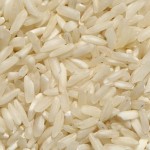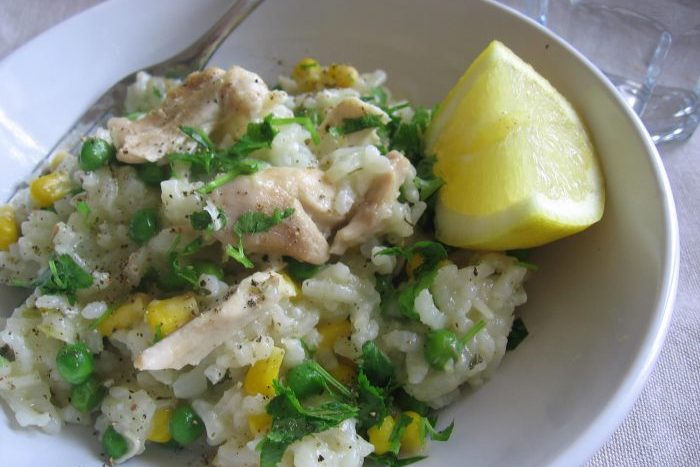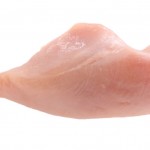Leftover cooked chicken transformed into a tasty risotto with garlic, herbs & lemon. Use dried herbs if you don’t have fresh herbs available. To make homemade chicken stock, simmer the carcass in water with some celery, onion and herbs for 2-3 hours. Freeze in 500 ml portions to give you a tasty base for soups, risottos and stews.
Skills Check
Follow a recipe; follow food safety and hygiene rules; tidy away; use measuring spoons; use a jug to measure liquids; use weighing scales; cut using bridge/claw technique safely; snip herbs with scissors; use a box grater safely; tear herbs; crush garlic; use a citrus squeezer/zester; use the hob (with adult supervision); season to taste; garnish and decorate.
Equipment
Saucepan; knife; chopping board, wooden spoon; measuring spoons; measuring jug; weighing scales; ladle; box grater; citrus zester/juicer.
Allergens (Please note the allergens listed above are indicative only. Allergens vary depending on brand; check the labels on the products you use)
Celery | Milk
Ingredients (serves 2):
- 2 tsp olive oil
- 1 small onion, peeled and finely chopped
- 1 stick of celery, washed and finely chopped
- 1 clove of garlic, peeled and finely chopped
- 150 g risotto rice
- 600 ml chicken stock
- 1 tsp dried mixed herbs
- 80 g frozen peas
- 80 g frozen sweetcorn
- 100 g cooked chicken, cut into small pieces
- 1/2 lemon, zest and juice
- 1 tbsp Parmesan cheese, finely grated
- Small handful of fresh herbs, washed and finely chopped (e.g. coriander, parsley, basil)
- Black pepper, to taste
Method
- Heat the oil in a large saucepan, add the chopped onion and celery, and cook on medium heat until it is soft (about 10 minutes).
- Add the chopped garlic and cook for another minute.
- Stir in the rice and dried herbs and mix well.
- Add the stock a ladle at a time, stirring often and adding more when all the liquid is absorbed, cooking for around 15 minutes until the rice is almost cooked (once all the stock is used add more hot water if the rice is drying out and sticky).
- Add the frozen peas & sweetcorn, lemon zest and cooked chicken, and stir well. Heat for about 10 minutes until the peas and sweetcorn are cooked and the chicken piping hot. The rice should be creamy but still have a firm bite.
- Stir in the lemon juice and cheese and some freshly ground black pepper.
- Divide the risotto between bowls. Garnish with fresh herbs (if you have some to spare). Serve immediately.
So thinking about lemony chicken risotto ...

Chicken is an excellent source of protein, vitamins and minerals. Protein is essential for building and repairing our bodies.
Vegetables are are so good for us! Low in fat, sugar and calories and high in vitamins and minerals.
Nutritional Information
| - | Energy | 2321kJ / 550kcal | 28% |
| Low | Fat | 12.2g | 17% |
| Low | Saturates | 4.0g | 20% |
| Low | Sugars | 7.3g | 8% |
| Low | Salt | 1.4g | 24% |
per 526g serving
% of an adult's reference intake
Typical values per 100g: Energy 441kJ / 105kcal
Notes
A traffic light system is used on nutrition labels to make it easier to see which foods and drinks are lower in calories, fat, sugar and salt. Try and choose more ‘greens’ and ‘ambers’ and fewer ‘reds’, and stick to smaller portions of ‘reds’.
Just because a recipe or a food has a red traffic light doesn’t mean you shouldn’t eat it. Understanding why a food or recipe might have a red light can be helpful. For example oily fish is high in total fat and so any recipe containing oily fish is likely to be ‘red’ for fat. But it is recommended that we eat oily fish at least once a week because the type of fat it contains is beneficial for our health.
% Reference Intakes are also shown. Reference Intakes are guidelines about the approximate amount of particular nutrients and energy required for a healthy diet (based on an average-sized woman doing an average amount of physical activity). Most children will require less than these Reference Intakes. The contribution of one serving of a food or drink to the Reference Intake for each nutrient is expressed as a percentage.




